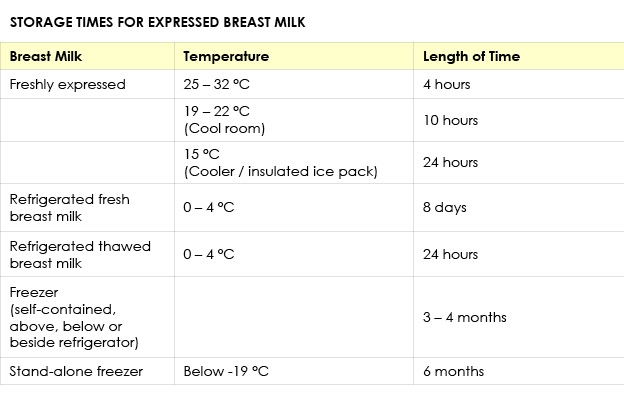SingaporeMotherhood | Baby & Toddler
July 2013
14 Pumping Tips for Working Mothers who are still Breastfeeding their Baby

Many mothers choose to feed their babies expressed breast milk (EBM) while they, the mums, are at work. This motivation to continue feeding breast milk stems from a desire to provide their babies with the health benefits and the emotional closeness of continued breastfeeding. Find out how to prepare for the transition from total latching to expressing while at work. These tips will also help you work out your workplace pumping plans.
1. Delay your return to work
In her survey of 567 employed nursing mothers in 1984, lactation consultant and La Leche League Leader Kathleen Auerbach found that it is your baby’s age when you go back to work, rather than the number of hours worked weekly, that affects the course of breastfeeding.
2. Explore alternative arrangements
If your company allows flexible working arrangements, why not take the opportunity to try this out? You could also consider part-time work, working from home, running a home or web-based business, or flexi-work. In these circumstances, latch your baby to breastfeed when you are home, in the evenings and on weekends. This helps with bonding, baby’s oral development, and your milk supply.
(See also: CHILD CARE OPTIONS IN SINGAPORE)
3. Build an expressing community
Are there other mums in your workplace who are expressing at work? Join a support group of other working, nursing mothers and share your experiences! Tips and encouragement from more experienced mums will help you through challenges!
4. Plan!
Your baby’s age and dependence on breast milk for nutrition will determine how intensively you prepare before going back to work. Says lactation consultant Wendy Deshpande, “A mother who is returning to work within the first couple of months will prepare very differently from a mother who returns after six months.”
Discuss ‘lactation breaks’ with your employer before giving birth or returning to work after maternity leave. Explain how long pumping will take, and how you will maximise your office time. Some mothers take shorter lunch breaks or begin work earlier.
Consider your workplace facilities. Some mothers who do not have a nursing room in their office pump in their cubicles. Full-time working mother Tengku Suhailah shares, “I express at my workstation, under a scarf. I also hide my pump under a pillow, and turn on music to muffle its sound.”
5. Choose an appropriate breast pump
Most full-time working mothers find that double-sided, electric pumps are efficient, affordable and lightweight for their needs.
Think:
- Will a manual (eg. squeeze-handle pump), single-sided or double-sided electric or hospital-grade pump be the most suitable?
- How often will I use it?
- Can the pump extract breast milk quickly?
- Will the pump be able to help maintain my supply in the long-term?
Comparing Pumps:
- Manual pumps are inexpensive but require skill to regulate pumping rhythm.
- Double pumps save time and may help increase milk supply better than single-sided pumping.
- Hospital-grade pumps are suitable for multiple pumps a day. Built for performance and endurance, they extract milk quickly and maintain production
- Smaller, cheaper pumps may not be able to draw milk efficiently, affecting milk supply.
(See also: 11 BEST BREAST PUMPS FOR BREASTFEEDING MUMS IN SINGAPORE)
6. Don’t go second-hand
Using second-hand pumps carries risks. Most single-user pumps have ‘open systems’. This means that there are no protective barriers to prevent cross-contamination if more than one person is using the pump.
Some internal pump parts cannot be removed, cleaned, or replaced. Disease organisms from the breast milk of an infected mother can be transmitted to another pump user. Blood contamination may also occur if the previous user had cracked nipples. Breast pump motors become less efficient over time. A well-used pump may not provide adequate stimulation to maintain milk supply.
7. One bottle a day
Give baby a bottle a day after breastfeeding is established. This usually happens when baby is between four and six weeks of age. Any later could result in baby resisting the bottle. Ms Deshpande shares, “There is a window of opportunity around this time for introducing a bottle to a breastfed baby. Beyond six weeks, the baby may refuse and become distressed, adding to the stress of a mother who is already anxious about leaving baby and beginning work.”
8. Increase production before returning to work
Pump several times a day in addition to breastfeeding, at least one or two weeks before beginning work, suggest the authors of Making More Milk. If that sounds like a little too much, do it at least once a day. “Introduce a pumping session at roughly the same time every day, usually in the morning after the first feed. Most mums have the most milk at this time. This effectively tells your body that your baby needs an extra feed at this time. Your production soon increases,” Ms Deshpande advises.
9. Build a Breast Milk stockpile
Do this at least three to four weeks before you return to work. “Most mums feel reassured if they have a fair amount of frozen expressed milk. It relieves the pressure on them to pump substantial amounts while at work as many mums experience a dip in supply when they first return to work. A small stash is like an insurance policy,” shares Ms Deshpande.
10. Pump like Baby feeds
At work, pump as often as your baby would feed in that time period. “I try to express at least three times a day at specific times. If meetings go beyond scheduled pumping times, I simply adapt accordingly,” says Tengku Suhailah, a full-time working mother to two boys.
11. How much does Baby need?
Determine how much breast milk your baby will require while you are away. If Baby is exclusively breastfed, his daily intake will increase during the first weeks of life, reaching a plateau of 600 – 1000 ml in the first month. His daily requirement will not change until he is six months old.
Divide the total daily requirement by the number of feedings he has daily. Multiply this by the number of feeds he has while you work. Note though that this method is only a guide. Your baby’s nutritional needs are unique, so take note of his feeding cues. They are the best indicator of how much he needs.
12. Store milk in 50 ml amounts
This makes for easier thawing, less wastage, and better portability!
13. Increase output
Encourage ‘let-down’ while pumping. Try breast massage, breast compression, looking at your baby’s pictures or thinking about your baby. Nursing more or adding pumping sessions may also help. Nur Yahya, who worked full-time in international relations shares, “When supply dipped after a busy work period, I took time off to stay at home for a latch-and-pump marathon. After two days of latching, pumping and recuperating, there was a marked increase in milk supply!”
14. Cut down for older babies
If your baby is taking solids, you can gradually cut down on the amount that you are expressing. While you are at work, tell his caregiver to let him eat solids before having EBM. This helps to reduce his need for milk while you are away, say the authors of The Breastfeeding Mother’s Guide to Making More Milk.
Successful pumping and working involves trial-and-error. During your pumping moments, focus on your nursing relationship with your baby. This will help you to persevere, and ultimately prolong your breastfeeding journey for your child!
All content from this article, including images, cannot be reproduced without credits or written permission from SingaporeMotherhood.
Follow us on Facebook, Instagram, and Telegram for the latest article and promotion updates.








